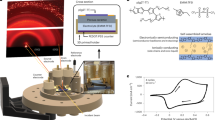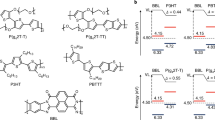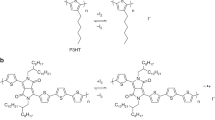Abstract
Conducting organic materials, such as doped organic polymers1, molecular conductors2,3 and emerging coordination polymers4, underpin technologies ranging from displays to flexible electronics5. Realizing high electrical conductivity in traditionally insulating organic materials necessitates tuning their electronic structure through chemical doping6. Furthermore, even organic materials that are intrinsically conductive, such as single-component molecular conductors7,8, require crystallinity for metallic behaviour. However, conducting polymers are often amorphous to aid durability and processability9. Using molecular design to produce high conductivity in undoped amorphous materials would enable tunable and robust conductivity in many applications10, but there are no intrinsically conducting organic materials that maintain high conductivity when disordered. Here we report an amorphous coordination polymer, Ni tetrathiafulvalene tetrathiolate, which displays markedly high electronic conductivity (up to 1,200 S cm−1) and intrinsic glassy-metallic behaviour. Theory shows that these properties are enabled by molecular overlap that is robust to structural perturbations. This unusual set of features results in high conductivity that is stable to humid air for weeks, pH 0–14 and temperatures up to 140 °C. These findings demonstrate that molecular design can enable metallic conductivity even in heavily disordered materials, raising fundamental questions about how metallic transport can exist without periodic structure and indicating exciting new applications for these materials.
This is a preview of subscription content, access via your institution
Access options
Access Nature and 54 other Nature Portfolio journals
Get Nature+, our best-value online-access subscription
$29.99 / 30 days
cancel any time
Subscribe to this journal
Receive 51 print issues and online access
$199.00 per year
only $3.90 per issue
Buy this article
- Purchase on Springer Link
- Instant access to full article PDF
Prices may be subject to local taxes which are calculated during checkout




Similar content being viewed by others
Data availability
All relevant data is included in the supplementary information. The raw datasets are available from the corresponding author upon request.
Code availability
The codes used in this study are available in the repository at https://github.com/damazz/NiTTFtt.
References
Heeger, A. J. Nobel Lecture: Semiconducting and metallic polymers: the fourth generation of polymeric materials. Rev. Mod. Phys. 73, 681–700 (2001).
Bryce, M. R. Recent progress on conducting organic charge-transfer salts. Chem. Soc. Rev. 20, 355 (1991).
Valade, L., de Caro, D., Faulmann, C. & Jacob, K. TTF[Ni(dmit)2]2: from single-crystals to thin layers, nanowires, and nanoparticles. Coord. Chem. Rev. 308, 433–444 (2016).
Xie, L. S., Skorupskii, G. & Dincă, M. Electrically conductive metal–organic frameworks. Chem. Rev. 120, 8536–8580 (2020).
Guo, X. & Facchetti, A. The journey of conducting polymers from discovery to application. Nat. Mater. 19, 922–928 (2020).
Bubnova, O. et al. Semi-metallic polymers. Nat. Mater. 13, 190–194 (2014).
Kobayashi, A., Fujiwara, E. & Kobayashi, H. Single-component molecular metals with extended-TTF dithiolate ligands. Chem. Rev. 104, 5243–5264 (2004).
Kobayashi, Y., Terauchi, T., Sumi, S. & Matsushita, Y. Carrier generation and electronic properties of a single-component pure organic metal. Nat. Mater. 16, 109–114 (2017).
Venkateshvaran, D. et al. Approaching disorder-free transport in high-mobility conjugated polymers. Nature 515, 384–388 (2014).
Joo, Y., Agarkar, V., Sung, S. H., Savoie, B. M. & Boudouris, B. W. A nonconjugated radical polymer glass with high electrical conductivity. Science 359, 1391–1395 (2018).
Plummer, J. Is metallic glass poised to come of age? Nat. Mater. 14, 553–555 (2015).
Hirata, A. et al. Geometric frustration of icosahedron in metallic glasses. Science 341, 376–379 (2013).
Eisenberg, R. & Gray, H. B. Noninnocence in metal complexes: a dithiolene dawn. Inorg. Chem. 50, 9741–9751 (2011).
McCullough, R. D. et al. Building block ligands for new molecular conductors: homobimetallic tetrathiafulvalene tetrathiolates and metal diselenolenes and ditellurolenes. J. Mater. Chem. 5, 1581 (1995).
Xie, J. et al. Redox, transmetalation, and stacking properties of tetrathiafulvalene-2,3,6,7-tetrathiolate bridged tin, nickel, and palladium compounds. Chem. Sci. 11, 1066–1078 (2020).
de Caro, D. et al. Metallic Thin films of TTF[Ni(dmit)2]2 by electrodeposition on (001)-oriented silicon substrates. Adv. Mater. 16, 835–838 (2004).
Scott, R. A. Comparative X-ray absorption spectroscopic structural characterization of nickel metalloenzyme active sites. Phys. B Condens. Matter 158, 84–86 (1989).
Holder, C. F. & Schaak, R. E. Tutorial on powder X-ray diffraction for characterizing nanoscale materials. ACS Nano 13, 7359–7365 (2019).
Tanaka, H., Okano, Y., Kobayashi, H., Suzuki, W. & Kobayashi, A. A three-dimensional synthetic metallic crystal composed of single-component molecules. Science 291, 285–287 (2001).
Vogt, T. et al. A LAXS (large sngle X-ray dcattering) and EXAFS (extended X-ray absorption fine structure) investigation of conductive amorphous Nickel tetrathiolato polymers. J. Am. Chem. Soc. 110, 1833–1840 (1988).
Liu, Z. et al. Controlling the thermoelectric properties of organometallic coordination polymers via ligand design. Adv. Funct. Mater. 30, 2003106 (2020).
Choy, C. L., Leung, W. P. & Ng, Y. K. Thermal conductivity of metallic glasses. J. Appl. Phys. 66, 5335–5339 (1989).
Sun, L. et al. A microporous and naturally nanostructured thermoelectric metal-organic gramework with ultralow thermal vonductivity. Joule 1, 168–177 (2017).
Craven, G. T. & Nitzan, A. Wiedemann–Franz Law for molecular hopping transport. Nano Lett. 20, 989–993 (2020).
Dou, J. H. et al. Signature of metallic behavior in the metal-organic frameworks M3(hexaiminobenzene)2 (M = Ni, Cu). J. Am. Chem. Soc. 139, 13608–13611 (2017).
Kaiser, A. B. Electronic transport properties of conducting polymers and carbon nanotubes. Reports Prog. Phys. 64, 1–49 (2001).
Halim, J. et al. Variable range hopping and thermally activated transport in molybdenum-based MXenes. Phys. Rev. B 98, 104202 (2018).
Lan, X. et al. Quantum dot solids showing state-resolved band-like transport. Nat. Mater. 19, 323–329 (2020).
Kang, S. D., Dylla, M. & Snyder, G. J. Thermopower-conductivity relation for distinguishing transport mechanisms: polaron hopping in CeO2 and band conduction in SrTiO3. Phys. Rev. B 97, 235201 (2018).
Heeger, A. J. Disorder-induced metal-insulator transition in conducting polymers. J. Supercond. 14, 261–268 (2001).
Jiang, Y. et al. Synthesis of a copper 1,3,5-triamino-2,4,6-benzenetriol metal–organic gramework. J. Am. Chem. Soc. 142, 18346–18354 (2020).
Lee, K. et al. Metallic transport in polyaniline. Nature 441, 65–68 (2006).
Mazziotti, D. A. Large-scale semidefinite programming for many-electron quantum mechanics. Phys. Rev. Lett. 106, 083001 (2011).
He, T., Stolte, M. & Würthner, F. Air-stable n-channel organic single crystal field-effect transistors based on microribbons of core-chlorinated naphthalene diimide. Adv. Mater. 25, 6951–6955 (2013).
Huang, X. et al. Superconductivity in a copper(II)-based coordination polymer with perfect Kagome structure. Angew. Chemie Int. Ed. 57, 146–150 (2018).
Gill, N. S. & Nyholm, R. S. Complex halides of the transition metals. Part I. Tetrahedral nickel complexes. J. Chem. Soc. 1959, 3997–4007 (1959).
Ravel, B. & Newville, M. ATHENA, ARTEMIS, HEPHAESTUS: data analysis for X-ray absorption spectroscopy using IFEFFIT. J. Synchrotron Radiat. 12, 537–541 (2005).
Rehr, J. J. & Albers, R. C. Theoretical approaches to X-ray absorption fine structure. Rev. Mod. Phys. 72, 621–654 (2000).
Toby, B. H. & Von Dreele, R. B. GSAS-II: the genesis of a modern open-source all purpose crystallography software package. J. Appl. Crystallogr. 46, 544–549 (2013).
Yang, X., Juhas, P., Farrow, C. L. & Billinge, S. J. L. XPDFsuite: an end-to-end software solution for high throughput pair distribution function transformation, visualization and analysis. https://arxiv.org/abs/1402.3163 (2014).
Morrison, C., Sun, H., Yao, Y., Loomis, R. A. & Buhro, W. E. Methods for the ICP-OES analysis of semiconductor materials. Chem. Mater. 32, 1760–1768 (2020).
Ma, T., Dong, B. X., Grocke, G. L., Strzalka, J. & Patel, S. N. Leveraging sequential doping of semiconducting polymers to enable functionally graded materials for organic thermoelectrics. Macromolecules 53, 2882–2892 (2020).
Giannozzi, P. et al. QUANTUM ESPRESSO: a modular and open-source software project for quantum simulations of materials. J. Phys. Condens. Matter 21, 395502 (2009).
Giannozzi, P. et al. Advanced capabilities for materials modelling with Quantum ESPRESSO. J. Phys. Condens. Matter 29, 465901 (2017).
Marzari, N., Vanderbilt, D., De Vita, A. & Payne, M. C. Thermal contraction and disordering of the Al(110) surface. Phys. Rev. Lett. 82, 3296–3299 (1999).
Prandini, G., Marrazzo, A., Castelli, I. E., Mounet, N. & Marzari, N. Precision and efficiency in solid-state pseudopotential calculations. NPJ Comput. Mater. 4, 72 (2018).
Lejaeghere, K. et al. Reproducibility in density functional theory calculations of solids. Science 351, aad3000 (2016).
Kokalj, A. XCrySDen—a new program for displaying crystalline structures and electron densities. J. Mol. Graph. Model. 17, 176–179 (1999).
Acknowledgements
This work was supported by the Army Research Office under grant no. W911NF-20-1-0091. D.A.M. and J.S.A. are grateful for support from the US Department of Energy (DOE), Office of Science, Office of Basic Energy Sciences, under award no. DE-SC0019215. H.C. and D.V.T., R.I. and D.A.M. thank the National Science Foundation for financial support under award nos CHE-1905290, CHE-1856684, and CHE-2155082, respectively. We thank N. Boynton and B. Ketter for assistance with Seebeck measurements, D. Laorenza and D. Freedman for assistance with diffuse reflectance spectroscopy, X. Jiang, Y. Fan, T. Luo and W. Lin for assistance with ICP–MS measurements, J.-A. Pan for assistance with ICP–OES measurements, H. Wu for assistance with the Dektak XT-S profilometer, A. Ritchhart for computational geometry optimizations, L. Wang for assistance with SEM and L. McNamara for help with EPR. We thank M. Goetz and the beamline staff, Y. Ding and K. Kucuk, for assistance with XAS measurements at the APS beamline 10-BM-A,B and L. C. Gallington for X-ray total scattering measurements at beamline APS 11-ID-B. The PDF measurements and analysis were supported as part of the Inorganometallic Catalyst Design Center, an Energy Frontier Research Center funded by the US DOE Basic Energy Sciences under award no. DE-SC0012702. This research used resources of APS and the Center for Nanoscale Materials, US DOE Office of Science User Facilities operated for the DOE Office of Science by Argonne National Laboratory under contract no. DE-AC02-06CH11357. Parts of this work were carried out at the Soft Matter Characterization Facility of the University of Chicago and with resources from the Research Computing Cluster. This work made use of the shared facilities at the University of Chicago Materials Research Science and Engineering Center, supported by National Science Foundation under award no. DMR-2011854.
Author information
Authors and Affiliations
Contributions
J.X. synthesized samples and performed their physical characterization. S.E. conducted band structure calculations. J-N.B. performed the molecular calculations. A.S.F performed and refined the structural determination. B.C. performed electrical measurements and gold depositions. T.M. and G.L.G. carried out the room-temperature Seebeck and four-probe conductivity measurements. N.Z. and R.I. collected Raman and specular reflectance IR spectra, respectively. X.S. performed the Kramers–Kronig analysis. H.C. measured variable-temperature Seebeck coefficients. Z.C. and K.W.C. collected and analysed the PDF data. J.X. and J.S.A. conceived and wrote the manuscript. B.C., S.N.P., D.V.T., J.P. and D.A.M interpreted the data and wrote the manuscript.
Corresponding author
Ethics declarations
Competing interests
J.S.A and J.X. are inventors on patent application no. 17771266 submitted by the University of Chicago that covers TTFtt-based coordination complexes and materials.
Peer review
Peer review information
Nature thanks Satoshi Horike and the other, anonymous, reviewer(s) for their contribution to the peer review of this work.
Additional information
Publisher’s note Springer Nature remains neutral with regard to jurisdictional claims in published maps and institutional affiliations.
Supplementary information
Supplementary Information
Supplementary methods, experiments, spectra and data including the sections Synthetic procedures, Structural characterization, Composition and vibrational characterization, Physical characterization, Stability tests, Demonstration experiments, Theoretical calculations and References.
Supplementary Video 1 Demo experiments.
Experiments demonstrating the use of NiTTFtt in light-emitting circuits and the stability of these circuits to acid/base in comparison to other common conducting materials.
Rights and permissions
Springer Nature or its licensor holds exclusive rights to this article under a publishing agreement with the author(s) or other rightsholder(s); author self-archiving of the accepted manuscript version of this article is solely governed by the terms of such publishing agreement and applicable law.
About this article
Cite this article
Xie, J., Ewing, S., Boyn, JN. et al. Intrinsic glassy-metallic transport in an amorphous coordination polymer. Nature 611, 479–484 (2022). https://doi.org/10.1038/s41586-022-05261-4
Received:
Accepted:
Published:
Issue Date:
DOI: https://doi.org/10.1038/s41586-022-05261-4
This article is cited by
-
Amorphous chalcogels with local crystallinity
Nature Communications (2022)
Comments
By submitting a comment you agree to abide by our Terms and Community Guidelines. If you find something abusive or that does not comply with our terms or guidelines please flag it as inappropriate.



